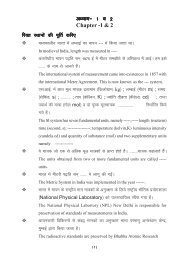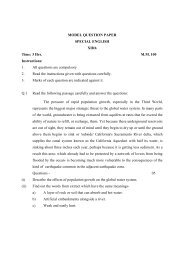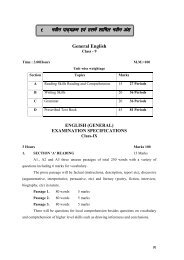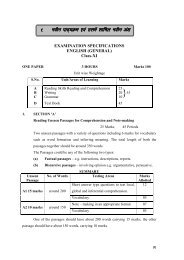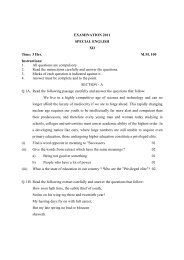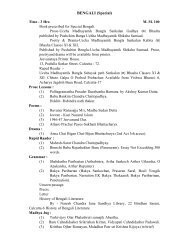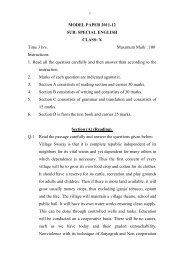- Page 1 and 2: ek/;fed f'k{kk e.My] e/;izns'k]Hkks
- Page 3 and 4: (a) Aryabhatt (b) Varachmihir(c) Br
- Page 5 and 6: 13- czãxqIr us dkSu&lh jpuk dh gS&
- Page 7 and 8: 22- HkkLdjkpk;Z dh jpukvksa dk vuqo
- Page 9 and 10: y?kq mÙkjh; ,oa nh?kZ mÙkjh; iz'u
- Page 11 and 12: v/;k;&2Unit-2leqPp;] la[;k i)fr ,oa
- Page 13 and 14: 8- leqPp;ksa vkSj muds xq.k/keksZa
- Page 15 and 16: The sum of Two sets are 30.(a) 5 (b
- Page 17 and 18: v/;k;&2Unit-2leqPp;] la[;k i)fr ,oa
- Page 19 and 20: 9- ;fn A vkSj B nks ,sls leqPp; gks
- Page 21 and 22: T ds 11T has 11∪∩n A( ∪∩A
- Page 23 and 24: 27. ,d lfefr esa 50 O;fDr ÝSap] 20
- Page 25 and 26: 4- _.k la[;kvksa] 'kwU; vkSj izkd`r
- Page 27 and 28: 11- ,slh dj.kh dks] ftldk ,d xq.kku
- Page 29 and 30: y?kq mRrjh; izdkj ds iz'uShort answ
- Page 31: (iv) 2√6-√5 (vi) 7√3-5√23
- Page 36 and 37: (1)(2)5 3 2 4 3+ +2 + 3 6 + 3 6 + 2
- Page 38 and 39: 3- fuEufyf[kr essa ls lR; dFku Nkaf
- Page 40 and 41: If R lies on 'O' then P will be lie
- Page 42 and 43: In A and B are two non-emply sets t
- Page 44 and 45: (iii) fcUnq (-1,2) v{k ds uhps dh v
- Page 48 and 49: 4- cgqinksa dks X dk ?kkrksa ds vkj
- Page 50 and 51: 11- cgqin 5x-4x 2 +3 dk eku D;k gks
- Page 52 and 53: (b)fdUgha nks cgqinksa esa xq.kuQy
- Page 54 and 55: (iii)nks ;k vf/kd cgqin dk HCF ;wfu
- Page 56 and 57: 3. xq.ku[kaMu dhft, % Factorise:(a)
- Page 58 and 59: Factorise each of the following:(a)
- Page 60 and 61: 14. fuEufyf[kr O;atdksa dk xq.ku[ka
- Page 62 and 63: (i) 4x 2 -3x+2 (ii) u 3 -u 2 - 2 (i
- Page 64 and 65: In each of the following subtract t
- Page 66 and 67: Divide(i) -3x 3 by x 2(vi) 5z 3 -6z
- Page 68 and 69: (15) x 3 +x 2 +x+1 (16) 7x 3 -3x 2
- Page 70 and 71: 53-- fcuk Hkkx fn, fl) dhft, fd x 4
- Page 72 and 73: 64. fuEufyf[kr cgqinksa dk y?kqre l
- Page 74 and 75: 3-dk eku Kkr dhft,AWhat is value of
- Page 76 and 77: 9- &3-6432 esa n'keyo &0-6432 _.kkR
- Page 78 and 79: If(a)then x is equal to -(b)(c)(d)2
- Page 80 and 81: y?kq ,oa nh?kZ mÙkjh; iz'uShort an
- Page 82 and 83: 5. lkjf.k;ksa dk iz;ksx djds fuEufy
- Page 84 and 85: fl) dhft,A / Prove that :(i) 3 long
- Page 86 and 87: Write each of the following numbers
- Page 88 and 89: 27 uhps nh xbZ izR;sd la[;k fdlh dk
- Page 90 and 91: Evaluate :(I) (ii) 0.054 ÷ 216.334
- Page 92 and 93: What must be the power of the varia
- Page 94 and 95: v/;k;&6Unit-6,d pj jkf'k dk ,d ?kkr
- Page 96 and 97:
A boy is now one-third as old as hi
- Page 98 and 99:
The perimeter of a rectangular fiel
- Page 100 and 101:
(1) 3x + 2 = 23 (2) 2y = 5 (3 + y)(
- Page 102 and 103:
A number consists of two digits. Te
- Page 104 and 105:
the second part and one fourth of t
- Page 106 and 107:
v/;k;&7Unit-7f=dks.kfefr(Trigonomet
- Page 108 and 109:
(a) 15cm (b) 13cm(c) 14cm(d) None10
- Page 110 and 111:
(c)(d)17. ;fnvkSj tan B = 3 rks fuE
- Page 112 and 113:
Note : y?kq mRrjh; ,oa nh?kZ mRrjh;
- Page 114 and 115:
v/;k;&7Unit-7f=dks.kfefr(Trigonomet
- Page 116 and 117:
42.43.44.- 2cos 2 45 0 - sin 2 0 0t
- Page 118 and 119:
55- ,d ehukj ds vk/kkj ls 30 eh- nw
- Page 120 and 121:
64- 120 eh- pkSM+h unh ds e/; esa]
- Page 122 and 123:
72. ,d [kacs ds vk/kkj fcanq ls] io
- Page 124 and 125:
v/;k; & 8UNIT-8okf.kT; xf.krCommerc
- Page 126 and 127:
7- ,d nqdkunkj us ,d oLrq dks 319-6
- Page 128 and 129:
15- 2500 : ij 6 % dh okf"kZd C;kt n
- Page 130 and 131:
23- ,d ewy?ku esa pØo`f) C;kt vkSj
- Page 132 and 133:
v/;k; &8UNIT-8okf.kT; xf.krCommerci
- Page 134 and 135:
8. ,d Fkksd O;kikjh QqqVdj nqdkunkj
- Page 136 and 137:
17. fuEu izdj.kksa esa ls izR;sd ew
- Page 138 and 139:
An automobile dealer buy an old mot
- Page 140 and 141:
31. ^jksth vkSj feV~Bw* uke dh daiu
- Page 142 and 143:
39. fdrus o"kksZa esa 6400 #- dk /k
- Page 144 and 145:
48 dfork ds cpr cSad [kkrs esa fuEu
- Page 146 and 147:
50. vydk dh iklcqd dk ,d i`"V fuEuk
- Page 148 and 149:
He closes the account on 01.10.2000
- Page 150 and 151:
59. lqczkeu;e cSad esa 1½ o"kZ ds
- Page 152 and 153:
fuEufyf[kr iz'uksa esa izfr'kr ykHk
- Page 154 and 155:
Find cost price when(1) selling pri
- Page 156 and 157:
83- lyhe us ,d Vsyhfotu xksiky dks
- Page 158 and 159:
11 6 %24In what time a sum of Rs. 1
- Page 160 and 161:
99- Losrk cSad esa 1 o"kZ ds fy, 90
- Page 162 and 163:
Whar correspondiance in in their ve
- Page 164 and 165:
12- ;fn fdlh f=Hkqt ds dks.kksas es
- Page 166 and 167:
22. ,d vk;r dk fod.kZ 10 ls-eh rFkk
- Page 168 and 169:
5. AB ,d js[kk[k.M gSA AB ds foifjr
- Page 170 and 171:
11 vkd`fr 8-37 esa] ABC lef}ckgq f=
- Page 172 and 173:
(Fig. 9.26)23. fl) dhft, fd fdlh pr
- Page 174 and 175:
In Fig. 9.29 ∆ ABC is isosceles w
- Page 176 and 177:
6- nh xbZ vkd`fr 6 esaesa AB > AC g
- Page 178 and 179:
16- ,d prqHkqZt ds fod.kZ ,d&nwljs
- Page 180 and 181:
¼3½;fn AD = 7.5 lseh rks GD dk ek
- Page 182 and 183:
v/;k;&10Unit-10lekarj prqHkqZt(Para
- Page 184 and 185:
7- ,dkgh vk/kkj ;k lokZaxle vk/kkjk
- Page 186 and 187:
5- ABCD ,d lekarj prqHkqZt gSaA BD
- Page 188 and 189:
17- f=Hkqt dh ,d Hkqtk ds e/; fcUnq
- Page 190 and 191:
= area. Prove that, QR bisects PS.(
- Page 192 and 193:
5. ;fn fdlh le cgqHkqt ds vUr%dks.k
- Page 194 and 195:
6- ,d le prqHkqZt ABCD dh jpuk dhft
- Page 196 and 197:
v/;k;&11Unit-11T;kferh; jpuk,a(Geom
- Page 198 and 199:
29 ,d oxZ dh jpuk dhft, ftlesa ,d f
- Page 200 and 201:
Unit-12lkaf[;dh StatisticsoLrqfu"B
- Page 202 and 203:
Show the following by a histogram.C
- Page 204 and 205:
7- d{kk 9oha ds Nk=ksa dh tUefrfFk
- Page 206 and 207:
Hkkj ¼fd-xzk- esa½Weight (in kg.)
- Page 208 and 209:
oxZ ¼nSfud etnwjh½ la[;kClass (da
- Page 210 and 211:
23- nks ikalksa dks ,d lkFk Qsadus


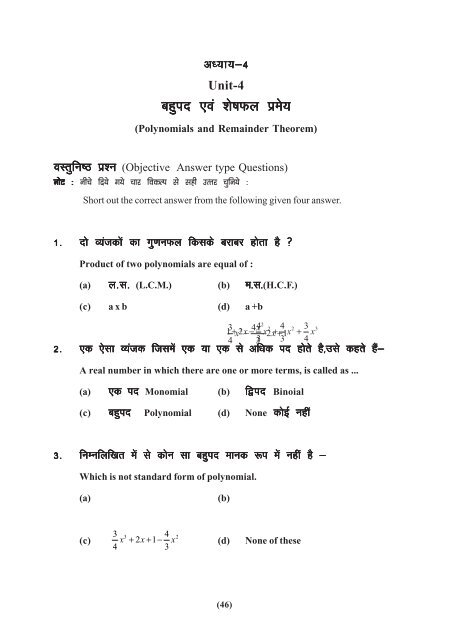
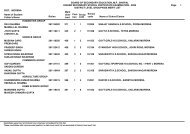
![ek/;fed f'k{kk e.My] e/;izns'k] Hkksiky - MP Board of Secondary ...](https://img.yumpu.com/50169371/1/184x260/ek-fed-fkkk-emy-e-iznsk-hkksiky-mp-board-of-secondary-.jpg?quality=85)
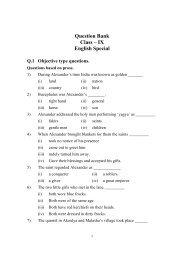
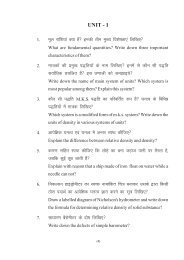
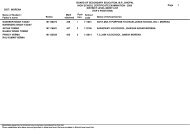

![ek/;fed f'k{kk e.My] e-iz-] Hkksiky](https://img.yumpu.com/47256614/1/184x260/ek-fed-fkkk-emy-e-iz-hkksiky.jpg?quality=85)
